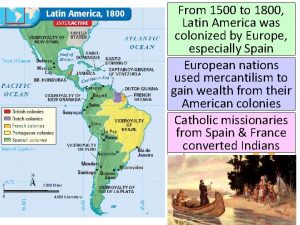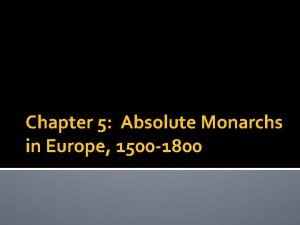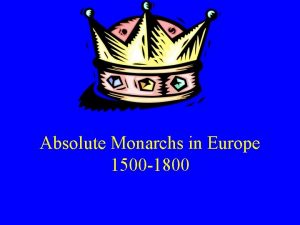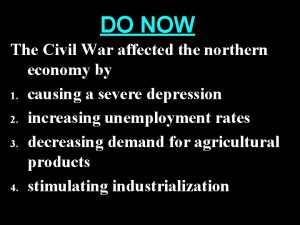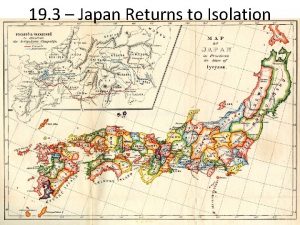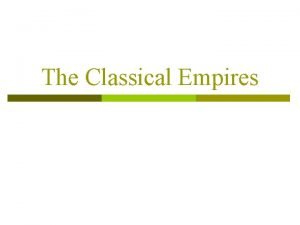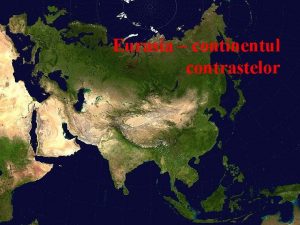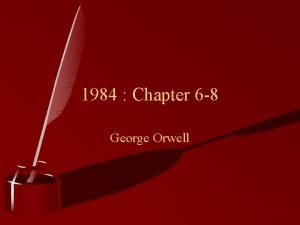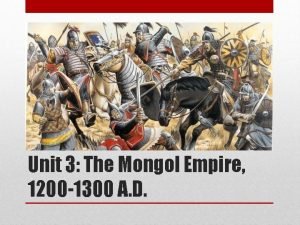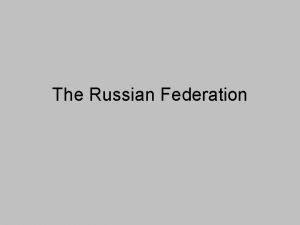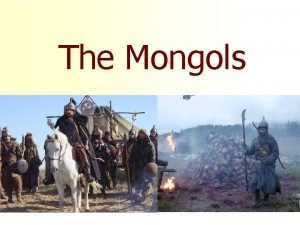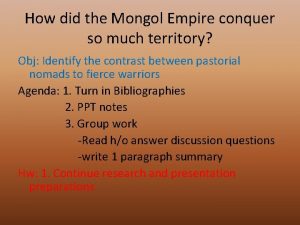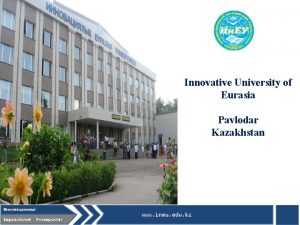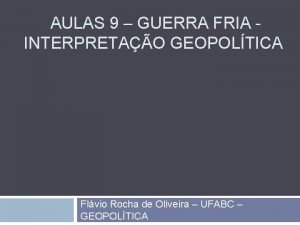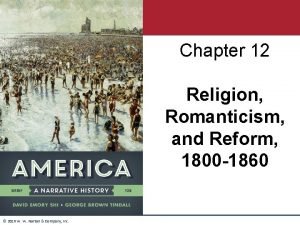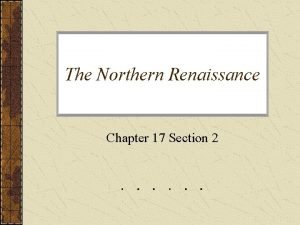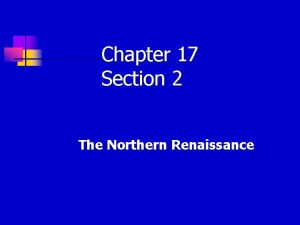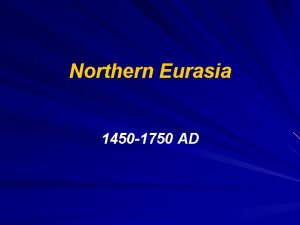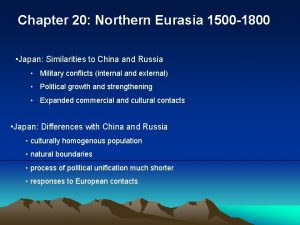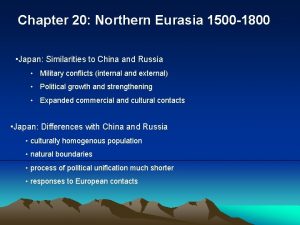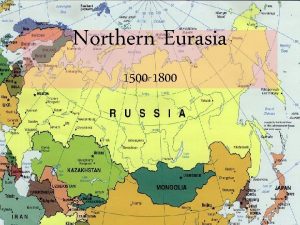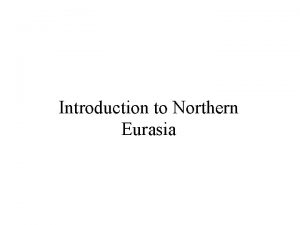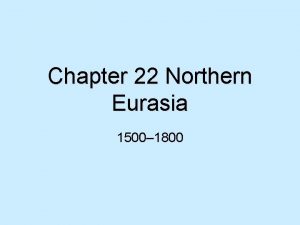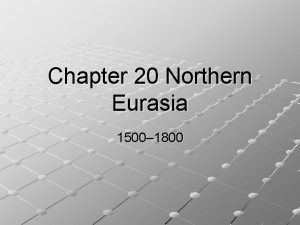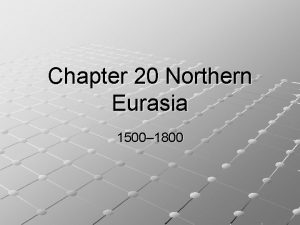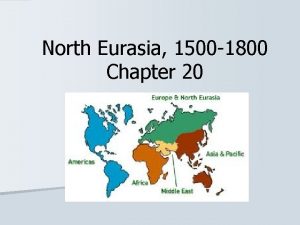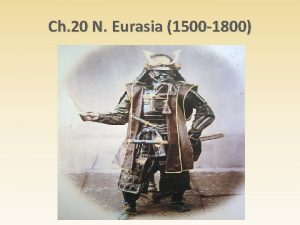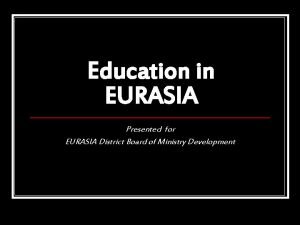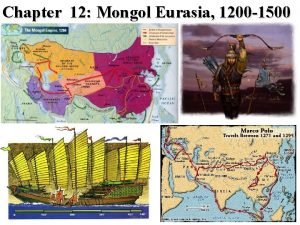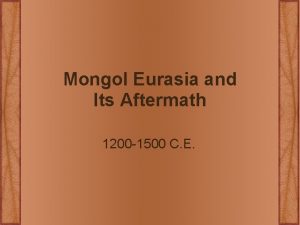Chapter 20 Northern Eurasia 1500 1800 Japan Civil




















- Slides: 20

Chapter 20: Northern Eurasia, 1500 -1800

Japan Civil War & the invasion of Korea (1500 -1603) §Daimyo & Samurai §Japan – attacked Korea - Hoping to conquer Korea and China - Turtle boats - Weakened Korea and strengthened Manchus Tokugawa Shogunate (to 1800) - Strong more centralized government

Japan and the Europeans • Jesuits arrive late 1500 s • Limited success in converting the regional lords, did make a significant number of converts among the farmers of southern and eastern Japan • Rural rebellion (1630 s) was blamed on Christians • Tokugawas ban Christianity, and close Japan to Europeans (with exception of few Dutch traders @ Nagasaki harbor) – Required to have certificates from Buddhist temples - shipwrecked sailors • Even placed restrictions on # of Chinese traders

Elite decline & social crisis Rice economy – transformation from military to civil society - Enriches rice traders, everyone else suffers - Samurai hurting financially – living on credit - laws requiring forgiveness of Samurai debts - Stability of Samurai linked to stability of Shogun - agriculture vs. merchants -1603 -1800 Economy grew faster than population Forty-Seven Ronin incident - Tradition vs civil authority - Tradition gives way, Ronin allowed to commit seppuku

Late Ming and Early Qing Empires The Ming Empire §Economic Growth ØDemand for Ming porcelain (“china”) ØChinese exports gobbled up the world’s silver ØLittle ice age effected China’s agriculture & political stability §Government policies and corruption lead to collapse Ming Collapse and the rise of the Qing §Mongols – Mongolia ØUnified in devotion to Dalai Lama (Tibetan Buddhism) Ø 1600 – Galdan restores them to military power §Manchus – Manchuria ØJapanese sought their help in 1592 -1598 invasion Ø 1644 – claimed China for their own when asked to help Ming general ØEstablish Qing Empire and adopt Chinese institutions and policies

Trade and missionaries §Trade ØPortuguese first on scene (1513), embassy (1517), expelled (1522) ØPortuguese trade from Macao (1557) ØSpanish traded from outpost in Taiwan (1662), then Manila §Dutch East India Company (VOC) – displaced Portuguese ØWilling to kowtow to emperor, (will maintain trade privileges) §Missionaries in China ØFranciscans, Dominicans (lower classes), and Jesuits (elites) ØMatteo Ricci – mastered language & classics, coopted Chinese culture into Catholicism ØJesuits also introduced latest science/technology

Emperor Kangxi (child prodigy) §Period of economic, military, cultural achievement §Repaired infrastructure, encouraged trade §Contact with Russia – Amur River ØTreaty of Nerchinsk (1689) – Jesuits used as interpreters ØFixed border along Amur river, regulated trade §Kangxi led troops to defeat Galdan and take Mongolia (1691) § http: //www. dartmouth. edu/~qing/WEB/GALDAN. html §Christian compromises ØTolerated Confucian ancestor worship ØBecomes a wedge, ultimately leads to missionaries expulsion

Chinese influences on Europe §Silk, tea, wallpaper, porcelain, jade, room dividers, fans, ivory – all via Canton §Qing political philosophy – championed by Voltaire as a model ruler Tea & diplomacy §Single point for all trade – Canton – Allowed control and taxation §Britain and the Trade Deficit ØBritish East India Co (EIC) replaces VOC §Macartney Mission ØBritish trade imbalance favoring China ØRefused to kowtow – just a knee Ø“Sorry, but I don’t need you” (letter to England) Population and social stress §Environmental Deterioration ØPopulation growth intensified demand for food ØBuilding leads to deforestation ØInfrastructure not maintained, corruption, inefficiency

The Russian Empire Drive across Northern Asia § Rise of Muscovy (center of pwr under Golden Horde) ØAnnexed Novgorod in (1478), threw off Mongol yoke (1480) ØExpanded South & East by Ivan IV, eventually to Ural Mts ØPromoted Moscow as 3 rd Rome, Tsar (Caesar)

§ Problem of seaport(s) ØOnly seaport (Arkhangelsk) frozen most of year ØCrimean Turks to south, Sweden to northwest ØSiberia to the east – untapped riches (esp fur) http: //www. worldology. com/Eur ope/europe_history_md. htm

§ First real attempt - Strogonov fur traders, move across Siberia all the way to Alaska ØTsar’s political control follows slowly – uses Siberia as a penal colony § Diversity of Siberia

§ Romanovs ØTime of Troubles – Swedish/Polish forces in Moscow ØBoyars (Nobles) support Mikhail Romanov (start of Romanov dynasty) § Serfs ØTied to land, hereditary ØLargest % of population

Russian society & politics to 1725 §Cossacks – bands/tribes living north of Black & Caspian Seas ØMore loyal to chieftain than political ruler ØUsed in the conquest of Siberia ØUsed to defend Russia from invaders

The Russian Empire … continued Peter the Great – greatest of the Romanovs §Westernization ØTraveled in disguise across Europe collecting technology ØRealized that Trade = $ to spend on military Ø Why the big emphasis on Westernization?

ØGreat Northern War (Sweden) gives Russia access to Baltic ØUses Scorched Earth Policy to defeat Charles XII ØSt. Petersburg “Window to the West” ØPeter’s statement to Europe Ø“One ups” which French monarch ØUpwards of 100, 000 serfs die building it Øhttp: //www. saint-petersburg. com/video/index. asp ØElites forced to move to St. Petersburg, dress European Ø Why? ØWomen in public, education opened up ØImitates Prussian Military ØWhy Prussia?

No horse!

Moscow St. Petersburg

Growth of Russia


Oprichniki
 Latin america 1500 to 1800
Latin america 1500 to 1800 5 monarchs of europe
5 monarchs of europe Characteristics of absolute monarchs
Characteristics of absolute monarchs What is the hemisphere of japan
What is the hemisphere of japan The civil war affected the northern economy by
The civil war affected the northern economy by Japan returns to isolation
Japan returns to isolation Civil rights webquest
Civil rights webquest Afro eurasia map
Afro eurasia map 1984 orwell map
1984 orwell map Pen ciukotsk
Pen ciukotsk 1984 chapter 6
1984 chapter 6 Cambulac mongolia
Cambulac mongolia Eurasia time zone
Eurasia time zone The mongol empire spans eurasia worksheet answer key
The mongol empire spans eurasia worksheet answer key The mongol empire spans eurasia answer key
The mongol empire spans eurasia answer key Innovative university of eurasia
Innovative university of eurasia Eurásia
Eurásia Eurásia
Eurásia Chapter 12 religion romanticism and reform
Chapter 12 religion romanticism and reform Chapter 17 section 2 the northern renaissance
Chapter 17 section 2 the northern renaissance The northern renaissance begins
The northern renaissance begins
